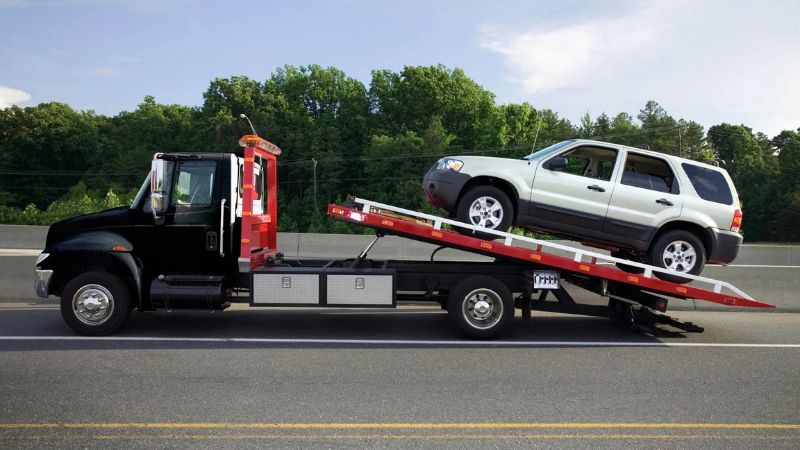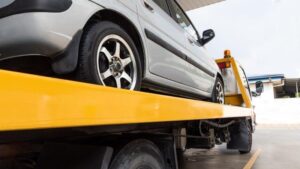Unexpected events can occur at any time when you’re driving. Having the appropriate towing equipment in your vehicle can make a big difference when you have a flat tire, engine issues, or become stuck in a ditch. The right equipment not only saves you time but can also ensure your safety in critical moments. In this guide, we’ll explore the top 10 towing tools every driver should be familiar with, helping you stay prepared for any roadside emergency. From tow straps to jumper cables and tire jacks, these tools can help you manage emergencies efficiently and get you back on the road quickly. Don’t wait for a breakdown to realize what you’re missing—equip yourself with these essential towing tools now to avoid stress and frustration later.
Top 10 Towing Tools Every Driver Should Know About
1. Tow Strap or Rope
A tow strap or rope is one of the most essential tools for any driver. It’s a heavy-duty strap made from durable materials like nylon or polyester, designed to handle significant weight. When your vehicle breaks down or gets stuck, a tow strap can be used to pull it to safety, as long as there’s another vehicle to assist. The strength of the tow strap is crucial, so it’s important to choose one with a high load capacity that can handle the weight of your vehicle. Some tow straps come with hooks or loops at the ends for easy attachment to the vehicles. Always ensure that you know how to properly attach the strap to both vehicles to avoid accidents. Having a tow strap or rope in your vehicle can help you get out of difficult situations without waiting for professional towing assistance.
Also Read:- Benefits of Calling a Professional Towing Service
2. Jumper Cables
Jumper cables are essential for any driver, especially when dealing with a dead battery. If your car battery dies, jumper cables allow you to connect your vehicle to another car’s battery for a quick charge, getting your car started again. Most jumper cables are color-coded (red for positive, black for negative), making them easy to use. Ensure you choose cables with thick gauge wires, as these provide better power transfer. Additionally, longer cables are preferable because they offer more flexibility in positioning vehicles. When using jumper cables, it’s important to follow proper safety procedures, such as connecting the positive cables first to avoid sparks. Having a reliable pair of jumper cables in your car can save you time and hassle if you ever find yourself with a dead battery.
3. Tire Jack
A tire jack is a must-have for any driver, especially if you experience a flat tire while on the road. This simple yet powerful tool is used to lift your car off the ground so you can remove and replace a damaged tire. There are several types of tire jacks, including scissor jacks and hydraulic jacks, each offering different lifting mechanisms. Scissor jacks are compact and easy to store, while hydraulic jacks are typically more powerful and easier to operate but bulkier. Make sure to choose a jack that’s compatible with your vehicle’s weight and frame. Additionally, it’s essential to know how to properly position and use the jack to avoid accidents. With a tire jack in your trunk, you’ll be prepared to quickly replace a flat tire and get back on the road.
4. Lug Wrench
A lug wrench is the tool you’ll need to remove and tighten the lug nuts that hold your wheels in place. When you’re changing a flat tire, a lug wrench is necessary for loosening the nuts before using the tire jack to lift the vehicle. Most vehicles come with a standard lug wrench, but investing in a higher-quality, cross-shaped wrench can provide better leverage, making it easier to turn the lug nuts. Some lug wrenches also come with extended handles or torque settings, which can make the process even smoother. Be sure to check that the lug wrench fits your vehicle’s lug nuts before you need it. Having this tool readily available will ensure you can efficiently change a tire without the frustration of struggling with tight or rusted lug nuts.
5. Tire Pressure Gauge
Maintaining proper tire pressure is essential for safe driving and extending the life of your tires. A tire pressure gauge is a small but vital tool that allows you to check the air pressure in your tires. Under-inflated or over-inflated tires can lead to poor handling, reduced fuel efficiency, and even blowouts. Tire pressure gauges come in various types, including digital, dial, and stick gauges. Digital gauges are typically the easiest to read and provide the most accurate measurements. Checking your tire pressure regularly with a gauge ensures that your tires are properly inflated, helping you avoid dangerous situations on the road. It’s an inexpensive and easy-to-use tool that every driver should keep in their car.
6. Portable Air Compressor
Another crucial tool that can assist you in maintaining appropriate tire pressure is a portable air compressor. With a portable air compressor, you can add air to your tires while you’re on the go, unlike a tire pressure gauge, which only indicates the current pressure. These gadgets are small and convenient to keep in your car. Many compressors can be used in roadside emergencies because they are powered by the 12V socket in your car. A portable air compressor can keep you from becoming stranded whether you need to fully fill a flat tire after applying tire sealant or inflate a low tire. It’s especially helpful for lengthy road trips or if you regularly travel to places with limited access to tire services.
7. Safety Triangles or Road Flares
Safety triangles or road flares are essential for warning other drivers if your vehicle breaks down or if you’re involved in an accident. These reflective devices should be placed a safe distance behind your car to alert oncoming traffic, especially at night or in low-visibility conditions. Safety triangles are made from highly reflective materials and can be set up in minutes. Road flares, on the other hand, provide a bright light source that’s visible from a greater distance. Both tools help prevent further accidents by making your vehicle more visible to other drivers. Every vehicle should have at least three safety triangles or a set of road flares in case of emergency. These tools are inexpensive but highly effective in keeping you safe during roadside incidents.
8. Tow Hitch
A tow hitch is a crucial component for towing a trailer or another vehicle. Installed on the rear of your car or truck, a tow hitch provides a strong connection point for towing loads. There are different types of tow hitches, including ball hitches, pintle hitches, and gooseneck hitches, each designed for specific towing purposes. When choosing a tow hitch, it’s important to ensure that it’s rated for the weight of what you’ll be towing. A properly installed tow hitch makes towing safer and easier, whether you’re pulling a trailer, boat, or another vehicle. Always double-check that your tow hitch is securely fastened before hitting the road to avoid accidents.
9. Winch
A winch is an essential tool for off-road enthusiasts or anyone driving in areas where getting stuck is a real possibility. Mounted on the front or rear of a vehicle, a winch uses a motor and cable system to pull your vehicle out of tough situations, like mud, snow, or sand. Winches come in different sizes and strengths, so it’s crucial to select one that matches the weight of your vehicle. Electric winches are the most common type and can be powered by your vehicle’s battery. A winch is not just for extreme off-roaders—it’s also useful for anyone who wants an added layer of security when driving in remote or challenging conditions. Having a winch can give you the confidence to tackle tough terrain without worrying about getting stuck.
Also Read:- Tips For Long Road Trip to Avoid a Tow
10. Emergency Tool Kit
An emergency tool kit is a compact collection of tools that can help you manage minor repairs or roadside issues. Typically, these kits include items like screwdrivers, pliers, duct tape, and even basic first aid supplies. Some emergency kits also include glass breakers and seatbelt cutters for extreme emergencies. Having an emergency tool kit ensures that you’re prepared to handle a wide range of situations, from fixing a loose bolt to securing a temporary fix on a leaky hose. These kits are easy to store and should be checked regularly to ensure all items are present and in working condition. While you hope to never need it, an emergency tool kit provides peace of mind, knowing that you’re prepared for the unexpected.
Conclusion
Having the right towing tools in your vehicle is crucial for dealing with any unexpected breakdowns or roadside issues. By keeping these essential items in your car, you’re prepared to handle situations safely and efficiently. The right tools can save time, money, and help you avoid unnecessary towing fees. Don’t let yourself be caught off guard—be prepared and stay safe by having these 10 towing essentials on hand.
FAQs
Why should I carry towing tools in my car?
Carrying towing tools ensures you’re prepared for roadside emergencies, saving time and potentially avoiding costly towing services.
What is the most important towing tool to have?
A tow strap or rope is one of the most essential towing tools, allowing you to pull a vehicle safely if it breaks down.



